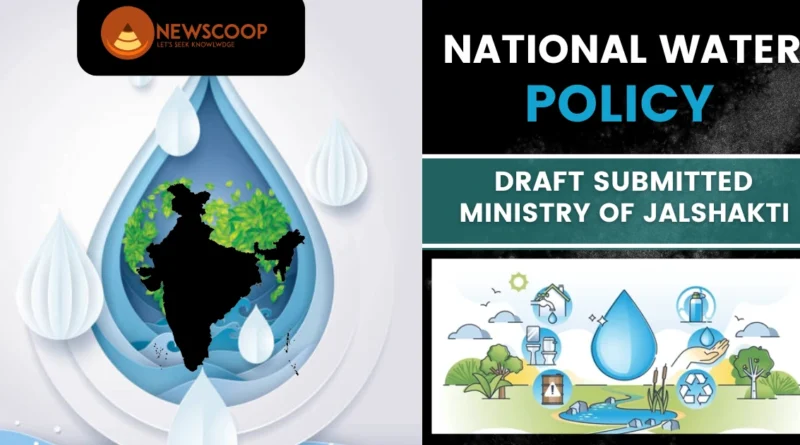National Water Policy UPSC: Key Reforms and Implications
India is a country rich in rivers, lakes, and groundwater resources. However, it is currently facing a serious water crisis. If we do not take urgent action, the water demand will exceed the available supply by the year 2030. In light of this concerning situation, the Government of India is working to revise and update the National Water Policy (NWP).
A draft has been submitted to the Ministry of Jal Shakti, which includes several recommendations that we will discuss in this article. Additionally, we will explore the issues with previous national water policies from 1987, 2002, and 2012 that have contributed to the current crisis, highlighting the need for a more effective approach to water management.
The National Water Policy is an important topic for the UPSC Mains Exam, particularly for General Studies Paper II and General Studies Paper III. Aspirants should not miss this topic, as it has a high chance of being asked in the upcoming UPSC exam.
Table of Contents
National Water Policy (NWP)
The National Water Policy (NWP) is a framework established by the Government of India to promote the efficient and sustainable use of water resources. The policy was first created in 1987 and was reviewed and updated in 2002 and 2012. Each update aimed to enhance water governance in response to increasing challenges such as water scarcity, pollution, and poor management.
As India faces a serious water crisis, the government is now focused on implementing important reforms to make the policy more effective in tackling the current issues in water resource management.
Key Focus Areas of the Policy:
- Ensure water availability for all sectors and communities.
- Promote water conservation through efficient usage and sustainable practices.
- Ensure equitable distribution of water for all, especially marginalized communities.
- Adopt integrated water resources management considering ecological, economic, and social factors.
- Regulate groundwater use to prevent over-exploitation and ensure sustainability.
- Protect the environment and maintain ecological balance in water bodies.
- Manage floods and droughts through effective preparedness and mitigation strategies.
- Enhance water use efficiency across all sectors, particularly agriculture.
Evolution of the National Water Policy
The National Water Policy of India has changed over time to tackle the increasing challenges of water resource management in the country. As the population has grown, along with industrialization and urbanization, India’s water resources have come under greater pressure.
The policy was first introduced in 1987. It was updated in 2002 and again in 2012 to respond to new challenges and include more effective solutions.
1. National Water Policy (1987)
The first National Water Policy was adopted in 1987. It established the groundwork for managing India’s water resources. It primarily focused on several key areas:
- National Perspective for Water Resources Planning: The policy recognized water as a national resource, emphasizing the importance of planning to meet national needs.
- Water Resource Planning: It utilized hydrological units, such as drainage basins and sub-basins, as the main units for effective water planning.
- Groundwater Management: The policy aimed to regulate groundwater exploitation to prevent overuse and ensure social equity among users.
- Irrigation Potential: It highlighted the importance of fully utilizing irrigation potential, particularly through the development of command areas to bridge the gap between potential and actual usage.
- Drinking Water Access: The policy set a goal to provide adequate drinking water facilities to all citizens by 1991.
2. National Water Policy (2002)
In 2002, the National Water Policy was reviewed and updated to address changes in the water sector and growing concerns about water scarcity and management. The key highlights of this update included the following:
- National and Regional Focus: The policy considered the overall needs of the country while also addressing the specific water needs of different regions.
- Water Resource Management: It emphasized managing water based on natural systems like rivers and lakes, and highlighted projects that serve multiple purposes, such as irrigation and drinking water.
- Groundwater Development: The policy aimed to improve declining groundwater levels by promoting better technologies and encouraging local communities to manage their water sources.
- Inter-basin Transfer: It recognized the need to transfer water between river basins to support areas with water shortages while considering the impact on local communities.
- Flood Management: The policy focused on non-structural measures, such as flood prediction and land use planning, to effectively manage flood risks.
3. National Water Policy (2012)
The latest version of the National Water Policy, created in 2012, aimed to take a more complete, sustainable, and efficient approach to managing water. This update considered the challenges of climate change, population growth, and urbanization. Key changes included:
- Integrated Water Management: A combined approach to address water needs at local, regional, state, and national levels.
- River Basin Planning: Emphasis on managing water based on river basins to ensure comprehensive care of water resources.
- Ecological Flow: Ensuring some river water is reserved for the environment to support ecosystems.
- Water Efficiency: Improving how water is used in projects and across river basins.
- Disaster Management: Focusing on preparedness for floods and droughts by restoring natural drainage systems.
- Access to Safe Water: Ensuring every household has access to a minimum amount of safe drinking water.
Draft New National Water Policy (NWP)
In November 2019, the Ministry of Jal Shakti set up a committee to draft a new National Water Policy (NWP). This was the first time the government involved independent experts in creating the policy. Over the next year, they received 124 suggestions from various stakeholders, including state governments, academics, and practitioners.
Why the New Water Policy is Needed?
The reason for the new policy is simple: India is facing a serious water crisis. Estimates suggest that by 2030, nearly half of India’s water demand will not be met. On top of this, groundwater levels are dropping, and water quality is worsening. With changing weather patterns, it has become harder to predict water availability. This means we need a new way to manage water resources, one that focuses on better usage and sustainability.
What Does the New Policy Focus On?
The new Draft National Water Policy focuses on several key ideas to help manage India’s water resources more efficiently. Below are the main points explained in simple terms:
1. Managing Water Demand Instead of Just Increasing Water Supply
Old Approach (Increasing Supply): Traditionally, India focused on increasing the supply of water, mainly by building more dams and water projects.
New Approach (Managing Demand): The new policy proposes managing the demand for water rather than just focusing on supplying more of it. This means:
- Changing farming patterns: Growing less water-intensive crops like pulses and grains instead of crops like rice and sugarcane that use a lot of water.
- Reducing water usage in industries: Encourage industries to use recycled water rather than taking more fresh water.
- Using treated wastewater: In cities, all non-drinking water uses (like for flushing toilets, washing cars, and gardening) should switch to treated wastewater (water that has been cleaned and is safe to reuse).
2. Better Use of Existing Water Resources
India is running out of new places to build big dams, and many regions are facing falling groundwater levels. So, the new policy focuses on using existing water more efficiently.
- Water delivery systems: The policy suggests using pressurized pipes to bring water from large dams directly to farmers so that water stored in dams reaches the fields more effectively. This helps reduce water wastage.
- Rejuvenating natural water sources: The policy promotes the idea of restoring natural water sources like rivers, wetlands, and catchment areas (the land that drains water into rivers). This can improve water supply and help local ecosystems.
3. Groundwater Management
Groundwater (water stored beneath the earth’s surface) is extremely important for India. The new policy gives the highest priority to managing groundwater properly so that we don’t overuse it and dry it up.
- Community involvement: Local communities should be involved in managing their groundwater resources. They should have access to information like where the groundwater is stored, how much is available, and how to use it sustainably.
- The policy suggests providing clear data on aquifers (underground water storage) to local communities so that they can better manage water use.
4. Protecting Rivers
Rivers are not just sources of water but also support ecosystems. The new policy focuses on protecting and revitalizing rivers.
- Rights of rivers: The policy suggests giving rivers the right to flow freely, without being blocked or diverted. Rivers should also be protected from excessive water extraction.
- This would ensure that rivers have enough water to sustain both human needs and the environment.
5. Water Quality Issues
Water quality in India is a big problem. Many rivers, lakes, and underground water sources are getting polluted. The new policy addresses this by:
- Setting up water quality departments in every government water ministry to monitor and improve water quality.
- Encouraging eco-friendly technologies for cleaning water, instead of harmful methods like reverse osmosis which wastes a lot of water.
Conclusion
The new National Water Policy highlights the government’s commitment to tackling India’s water crisis through sustainable management. By focusing on demand management, water efficiency, and rejuvenating natural water systems, the policy aims to secure the country’s water future.
Moreover, the government is also emphasizing community participation, technology adoption, and protecting rivers to address the growing challenges of water scarcity and pollution.

